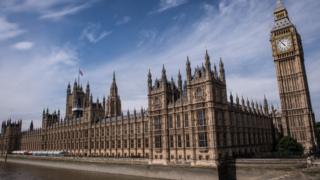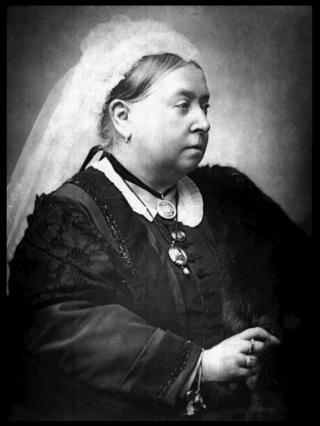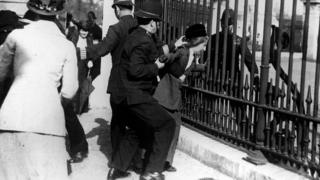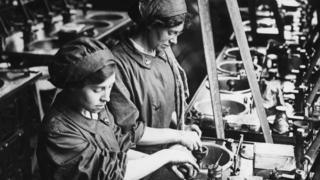what party fought for womens right to vote
To enjoy the CBBC Newsround website at its all-time yous will need to take JavaScript turned on.
100 years ago - on 6 February 1918 - an important law was passed which changed the Great britain forever.
It was called the Representation of the People Act 1918.

What was this law?
The Representation of the People Act 1918 was an important police because it allowed women to vote for the very first time. It too allowed all men over the historic period of 21 to vote too.
Before this law, women weren't immune to vote in general elections at all. Some men could vote, but not all of them - for example, a human had to take holding in society to be able to vote, so it excluded people who weren't as wealthy.
The contribution made during World War Ane past men and women who didn't have the right to fifty-fifty vote was an of import reason for the police force irresolute (find out more about this below).
 PA
PA
The Royal Mint, which makes the United kingdom's money, released a special 50p coin to marker 100 years since the Representation of the People Act 1918
Just fifty-fifty after the Representation of the People Human action 1918, men and women still didn't have the same rights when it came to politics.
The law said that women over the historic period of xxx who occupied a house (or were married to someone who did) could now vote. This meant 8.5 million women at present had their say over who was in Parliament - nearly 2 in every five women in the UK.
It also said that all men over the historic period of 21 could vote - regardless of whether or not they owned property - and men in the armed forces could vote from the historic period of 19. The number of men who could now vote went from viii one thousand thousand to 21 million.
Then the situation was still very unequal between men and women.
To enjoy the CBBC Newsround website at its all-time you volition need to take JavaScript turned on.
It was another 10 years earlier women were immune to vote in the same way that men could.
To enjoy the CBBC Newsround website at its best you lot volition demand to accept JavaScript turned on.
Yet, the Representation of the People Deed 1918 was an of import step in the fight for getting equality for women in social club.
So what's the story behind it?

Voting in the past
In a democracy, like the United kingdom today, members of the public get to vote for who they want to lead them and have more say in how the land is run.
Only this has not e'er been the case. In the past, the King or Queen had huge powers and there was very picayune that ordinary people could do to have a say in how they were governed.
In the early 1800s, there were even so very few people who could vote - and the ones that could were all men. Women didn't accept a say at all.
 PA
PA
The United kingdom is a democracy, which means that members of the public get to have their say over who represents them in Parliament
Just around this fourth dimension, things started to inverse. Throughout the 19th Century, groups like the Chartists campaigned to let all men to be able to vote.
In 1832 and 1867, laws were passed which did allow more men to vote than could before, but they still didn't apply to all men. For case, men yet had to be quite rich to have their say.
Meanwhile, women were still non allowed to take a say at all in who was in Parliament.

The role of women
Up until Victorian times (1837-1901), women had very few rights at all, especially once they were married. For example, anything they owned became their married man'due south property.
It was also traditionally thought that women shouldn't exist office of politics. Even Queen Victoria agreed!
 PA
PA
Even Queen Victoria didn't think that women should take anything to practice with politics
It was felt a adult female'due south place was at home, raising children and running the household.
More and more women were working in full-time jobs though. This made it easier for them to get together to discuss politics and problems which affected their lives - and many of them weren't happy about how society treated them so differently to men.

Time for change
When the laws were passed in the 19th century that gave men more voting rights, and women were still left out, they began to entrada for their right to be able to vote too.
Women wanted more equality in society in general, only their right to vote became the focus of their fight. At that place were men who campaigned for their right to vote too, simply it was non a popular opinion.
To bask the CBBC Newsround website at its best you will need to have JavaScript turned on.
The starting time petition to Parliament asking for women to become the vote was presented past a man called Henry Hunt on three Baronial 1832, just it was not successful.
Then, in 1867, a man called John Stuart Mill suggested to Parliament that the constabulary should be changed to give women the same voting rights as men. His proposal was likewise rejected by 194 votes to 73 - only it got the campaign going. (It's worth mentioning that at that place weren't whatever women in Parliament at this signal!)
 Getty Images
Getty Images
John Stuart Mill, pictured here, thought that women deserved the correct to vote too
Changes to the constabulary in favour of women getting the vote were presented in Parliament almost every year from 1870 onwards. But they weren't successful, so some women felt the campaign needed to exist turned upwards a notch!
I woman in particular who was very of import in the fight for women's right to vote was Emmeline Pankhurst.
To enjoy the CBBC Newsround website at its best you will need to have JavaScript turned on.
In 1903, she helped to start a group chosen the Women'southward Social and Political Union. Members of this group became the kickoff suffragettes - a group of women who fought hard for women's votes.
They got their name from the word suffrage, which ways right to vote.
Equally office of their candidature, suffragettes used to acquit out demonstrations, which were sometimes trigger-happy. In order to become their message heard, they would smash windows, fix burn to politicians' postboxes, refuse to swallow and chain themselves to railings.
 PA
PA
The suffragettes used to make it trouble with the police. In this photograph, a member of the group is being arrested by police officers during a protest outside Buckingham Palace in 1914
One suffragette called Emily Davison even gave her life for the cause, when she was killed afterward running out in forepart of the King'southward horse.
Many people supported women's right to be able to vote, only did not agree with the violent action of the suffragettes. They preferred to agree meetings, parade with banners, write letters or sign petitions.
To enjoy the CBBC Newsround website at its best you volition need to have JavaScript turned on.
A group called the National Union of Women'southward Suffrage Societies, which was formed in 1897, believed in using not-violent tactics to persuade the country that women deserved the vote.
They were called the suffragists and were led past another important figure in the fight for women's right to vote - a adult female called Millicent Fawcett. Emmeline Pankhurst had been a fellow member of this group originally.
Although the suffragists and the suffragettes used different methods, they both had one goal in mind - get women the vote.

Globe State of war One breaks out
In 1914, Globe War I broke out.
Many women took on jobs that men traditionally did, while they were away fighting.
Emmeline Pankhurst focused her efforts on helping the war effort and encouraged other suffragettes to exercise the same. She pointed out that there was no point in continuing to fight for the vote when there might be no country in which they could vote!
 Getty Images
Getty Images
During the state of war, many women took on jobs that men would traditionally do - for example, working in factories
Doing this gained for the women fighting for suffrage a lot of respect.
During this fourth dimension, there were no elections to cull a new government - and attitudes to women in society really started to modify.
A large reason for this was because of the contributions that women had fabricated to club throughout the state of war.
Women proved themselves to be every scrap as equal as men and the authorities promised to give women the vote when the war was finished.
In 1918, the Representation of the People Human activity was passed in February and women voted in the full general ballot for the very first time in Dec that year.

What has happened since?
The piece of work done by the suffragettes and suffragists in the years leading upward to World State of war I was extremely of import for women getting the right to vote.
But it wasn't until a law called the Equal Franchise Human activity in 1928 that suffrage was extended to all women over the age 21, meaning that women finally had the aforementioned voting rights every bit men.
Upwardly until 1918, women hadn't been allowed to be MPs in Parliament either. But a different law was passed in the same year as the Representation of People Human action which inverse this too. In December 1918, the first woman was elected to the House of Commons.
 Getty Images
Getty Images
The adult female on the right in this photograph is Constance Markievicz, the first woman to be elected to the House of Commons, in the general election of 1918
The Great britain has come a long way since and then in treating women the same fashion as men.
Before the 20th Century, there had certainly been no female prime ministers. At present, in that location have been two - including recent Prime number Minister Theresa May - and there are many female MPs.
But there are notwithstanding more male MPs in Parliament that in that location are women and there is nonetheless inequality in the UK betwixt men and women in other areas of life.
To enjoy the CBBC Newsround website at its best you volition need to have JavaScript turned on.
People are also treated differently because of their gender in other countries around the world, and so there is more piece of work to be washed - both in the UK and in other countries.
Many people continue to fight for equality with the hope is that one day everybody will be treated the aforementioned all over the world, regardless of their gender.
Source: https://www.bbc.co.uk/newsround/42794339
0 Response to "what party fought for womens right to vote"
Post a Comment